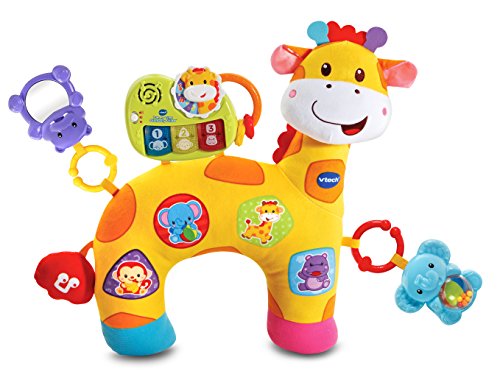Want to know more about baby tummy time?
It’s one of those parenting buzzwords that you’ve heard, but you’re not quite sure what it involves.
Tummy time plays a huge role in helping your tiny wobbly newborn develop into a curious crawling baby.
I know you want the best for your baby and tummy time is a great way to get them off to a good start.
This guide is to help answer all your questions about tummy time for your baby. That includes why you need tummy time, how to do tummy time and what to do if your baby hates it.
Now, this guide is crammed full of information that may be a bit overload to read in one go. I recommend you pin it to your baby boards to come back to it later.
Right, let’s do this Mama.
Pin For Later
Ultimate Baby Tummy Time Guide
What is baby tummy Time?
Tummy time is an essential skill your baby needs to learn.
Just as the name suggests, it involves baby lying on their tummy, or prone position, rather than on their back.
Now that doesn’t mean plonking your baby down on the floor and leaving them to it.
The most important part of tummy time is that you must interact with your baby.
As the building blocks for movement, you’ll need to do Tummy time until your baby can sit upright without support.
Importance of Tummy Time for Your Baby
You may be wondering just how vital tummy time is.
I mean sometimes it just seems like there is no time in the day to get anything done, never mind a few hours of tummy time.
However, neglecting tummy time can have serious consequences for your baby’s development.
Without Tummy time your baby may show delays in essential milestones such as rolling, crawling, and social skills.
Another issue is the official advice have your baby sleep on their back.
Now your newborn baby can sleep up to 20 hours a day. That’s a lot of time spend with their head on a firm surface. This can lead to physical problems for your baby’s fast-changing body.
Benefits of Tummy Time
Let’s look at the benefits of tummy time for your baby.
Develop Muscles
Tummy time will develop your baby’s back, neck, shoulder and arm muscles. All of these muscles are essential to progress your baby’s motor skills for rolling, sitting and crawling.
Coordination
Interaction with your baby during tummy time help your baby to progress their hand-eye coordination skills.
Stretching
Babies can suffer from ‘twisted neck’ or torticollis due to womb positions, childbirth or prolonged lying on their back. Tummy time allows your baby to get a full stretch from the neck down the spine.
Prevent flat head syndrome
This is a condition which caused your baby’s skull to become misshapen. It usually develops at a few months old due to prolonged periods of lying down. Tummy time is a great way to avoid this happening to your baby.
Bonding
Lots of skin to skin in the early days helps parents to bond with baby. The touch releases a hormone called oxytocin which increases the bond between you and your baby.
Social Skills
The interaction you have with your baby during tummy time will help your baby develop social skills. It acts as a foundation for them talking, problem-solving and interacting with others.
When To Start Tummy Time
You’re probably wondering ‘when do you start tummy time?’
It seems scary to do it with a newborn baby right?
It’s normal to be reluctant to start doing tummy time early, especially when your baby has no head control. But that’s exactly why you need to start as your baby is born.
Getting your baby to feel safe and comfortable in a front lying position can help avoid any problems as they grow.
Start with lots of skin to skin on your chest (or your partners) and then progress to the floor.
Remember it’s not all about playing with your baby on the floor.
Tummy time is about getting back to the basics of parenthood and interacting with your baby.
Newborn Tummy Time Tips
These are our tips for tummy time with a newborn.
Skin to skin
Start your baby with tummy time early by having lots of skin to skin on your chest. The touch and sound of your heartbeat and voice will make your baby feel safe in this position.
It’s also a great way to establish your milk supply or observe baby for hunger cues.
Tiger in the Tree
This is a position when you hold baby lying across your forearm. It’s a great way to get baby used to tummy time and can help to relieve colic for your baby.
You’ll love this positions for singing lullabies to your baby as you can easily move them up and down to the rhythm.
Use a baby carrier
Busy family life means you won’t have the luxury of too many lazy days with your baby.
Consider using a baby sling around the house or when out and about. These are amazing for bonding, breastfeeding and just generally getting shiz done.
Using a baby carrier tackles the problem of flat head caused by excessive use of bouncers, car seat or strollers.
Laidback breastfeeding
A side lying position is great for breastfeeding during the night. This can lead to your baby lying on one side more than another.
A great ‘tummy time’ position is laid back or biological nursing. Your baby lies on your tummy as you lay on your back.
It’s a great position for mums with large breasts or a fast milk ‘let down.’
Take it slow
Use the first month to allow your baby to adapt to a tummy time position. At this stage, too much interaction can cause your baby to become overstimulated.
Making your baby feel safe and secure in a front lying position will help you to progress to adding interaction into the mix.
How to Do Tummy Time
Once your baby is around one month old, they become more curious about the world around them. You can begin to add a lot more interaction to tummy time.
Let’s look at ways you can interact during tummy time.
Floor Play
As your baby begins to stay awake more during the day, that’s when the fun begins. You’ll need to keep them entertained.
Start placing your baby on the floor on top of a play mat or pillow for up to a minute. Slowly build up this time as you interact more with your baby.
Try to make tummy time a part of your daily routine.
Switch sides
If your baby is unable to support their head remember to alternate the side you turn their neck to.
I’d also recommend switching the direction you lay them down in the crib for each sleep. Babies prefer to turn their head to the side of the room you are on. This will help to even out the pressure the crib surface has on your baby’s head.
As your baby begins to lift, their head remember to interact with them using your face, voice or toys, equally on both side.
Massage
Tummy time doesn’t need to be all about play; you can make it relaxing for your baby too.
Use some safe baby oils and massage their neck and back during tummy time.
Baby massage helps to improve blood flow to hard working and fast growing muscles.
Read your baby
It’s important to observe your baby and how they are coping with tummy time. Remember to take it slow.
If your baby seems distressed, stop immediately and try again another time. Read my tips below for knowing when to avoid tummy time for your baby.
Tummy Time Activities by Age
All babies are different. However, you may want to know roughly when your baby will reach certain milestones. Your interaction with your baby during tummy time will depend on their age and motor skills.
One Month
At around one month old your baby should reach these milestones:
- Stares at Faces
- Responds to sound
- Smiling
Everything is still quite fuzzy to your baby as they can only see short distances. Try holding baby close to your face and speak to them.
They will recognize your tone and look in your direction. Smiling and making faces will help them to begin mimicking you.
Two months
During this month your baby should start to:
- Follows objects
- See Further
As your baby can now start to see further, it’s a great time to introduce toys. Noisy toys are great to help them recognize a difference between object and voices.
Use the toys and move them around, your baby will start to follow them bay moving their head around.
Help your baby adjust from skin to skin only to more floor time by getting down to their level.
Three to Four months
Your baby will start to move around more, and you’ll start to see:
- Head control
- Mini Push ups
Your baby will be able to interact a lot more during these months. This is a great time to encourage plenty of tummy time on the floor. An activity mat has lots of areas to hold your baby’s attention.
A soft mirrored toy will spark your baby’s interest.
Five to Six months
You’ll notice a huge change in baby’s abilities during these months. They’ll begin to interact with their surroundings more including:
- Grasping
- Rolling
- Sitting
Your baby will begin to purposefully move their arms and leg around more. Help encourage them to coordinate with lots of movement to songs or reaching for a toy.
Continue with your regular tummy time routine until your baby can sit unsupported.
Help, My Baby Hates Tummy Time
Your baby may appear to dislike tummy time by crying every time you place them into position.
It’s important that your baby is ready for tummy time. Otherwise, they will quickly become upset.
Let’s look at times when it’s best to avoid tummy time.
Discomfort
Try to avoid tummy time after a feed. Imagine how you would feel lying on your tummy after a big meal.
This is particularly important for babies who suffer from reflux as it can cause your baby to vomit.
Tired
It’s important to introduce tummy time slowly. Its hard work and your baby may only tolerate a few seconds at a time.
The important thing is to persevere and build up the length of time your baby can manage.
Overstimulated
All the interaction of tummy time can sometimes cause your baby to become overwhelmed.
Try to avoid tummy time after you’ve had lots of visitors or a busy day.
Full Nappy
Always check baby’s nappy before you start tummy time. A changing mat can be a great soft area for baby to begin tummy time before they can support their head.
Safe Tummy Time
It’s important you make tummy time a safe activity for your baby. Check out these tips for safe tummy time:
Sleep
Never place your baby on their tummy to sleep. It’s a huge risk factor for SIDS.
Make sure your baby has a good air supply and is awake at all time.
Observe
Never leave your baby in a front lying without an adult present. Don’t leave the room for even one minute. Your baby may restrict their air supply or vomit which can be fatal.
Safe environment
Your baby’s tummy should always be placed on a firm surface during tummy time. A prop can be used for the chest and arms such as a rolled towel or pillow.
Always place baby on the floor and never or a raised surface where they can roll and fall.
5 Best Tummy Time Products
Tummy time is a great way to interact with your baby. Check out these items which can help make regular tummy time a lot easier for you and fun for baby.
Baby Carrier

We’ve already discussed that baby carriers are a great way for baby to get tummy time through the day. A mei tai or wrap style sling (This one is my favorite) allows lots of skin to skin. The allow you to get on with your daily life while keeping baby close and having tummy time.
Tummy Time Mat
A baby play mat is a great way to transition baby onto the floor for tummy time. It provides a soft area for baby to play.
Activity mats often have lot of areas which are textured or noise to entertain baby.
You can even get mats deigned for Tummy Time with a slanted top or pillow to support your baby’s chest.
Tummy Time Mirror

Your baby loves to look at faces. Once they can hold their head up, place a play mirror in front of your baby. They will love to stare and interact with the cute baby smiling back.
A play mirror helps your baby to coordinate both sides of their brain for development.
Tummy Time Toys

Toys which stimulate your baby’s sight and sound sense will provide lots of stimulation. These are the senses which are developing before your baby learns to sit upright.
Tummy time toys which are soft, textured and noisy always go down a treat. They’ll help you interact with your baby during the early days, and they encourage independent play as they grow.
Tummy Time Pillow

I always recommend you support your baby’s chest during tummy time with a tummy time pillow. Look out for an activity mat which has a cushioned area, or use a rolled up towel.
If you have a nursing pillow they are the perfect curved shape to support baby during tummy time. They can also be used to curve around your baby’s bottom as they learn to sit unsupported.
Tummy Time FAQ
Am I too late to start tummy time?
If your baby is unable to unaided then it not too late to start tummy time. Start slowly, and you’ll see a big improvement with your baby’s progress.
How long should I do Tummy time?
Start with up to a minute a day in the prone position and build up every few days. Once your baby is around 4 months old, they should spend around 20 minutes a day having tummy time. You may need to reduce this if you baby is uncomfortable. It’s important to persevere and keep trying. Adding tummy time to your routine will make it become a habit for you and baby.
What if my baby doesn’t like tummy time?
Check that you are avoiding all the situations I’ve listed above which are known to make baby cranky. If your baby continues to become dislike tummy time even during ideal times, discuss with your care provider or doctor. There may be an underlying medical reason which requires follow up.
How Much Tummy Time does my baby need?
The key to tummy time success is constancy. That way your baby gets into the habit of the tummy time routine and is less likely to fuss.
The minimum time I recommend to new moms depends on your baby’s age. As a rule of thumb start with 30 minutes then add an extra 15 minutes each month.
- Newborn – minimum of 30 minutes per day during awake periods
- One month – minimum of 45 minutes per day
- Two months – minimum of 1 hr per day
- Three months – minimum of 1hr 15 min per day
- 4 months – minimum of 1hr 30 per day
- 5 months – minimum of 1hr 45 min per day
- 6 months – minimum of 2 hours per day
Around 7-8 months your baby should spend most of their day sitting unaided or learning how to sit.
Summary
Tummy time is a great activity for parents and babies to learn.
There are so many benefits to your baby’s physical and social development. That gives your baby a great start to developing skills for life.
I hope this guide has covered all your questions on tummy time. If not leave a comment below and I’ll be happy to help out.







